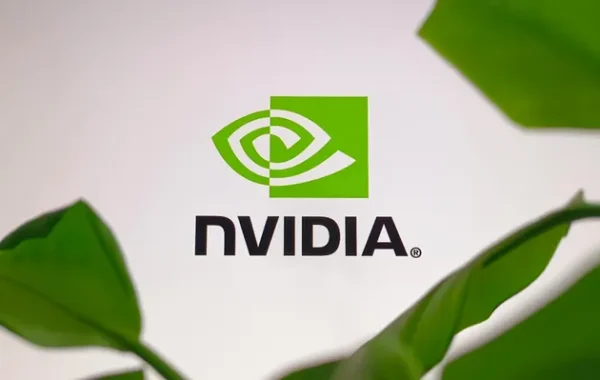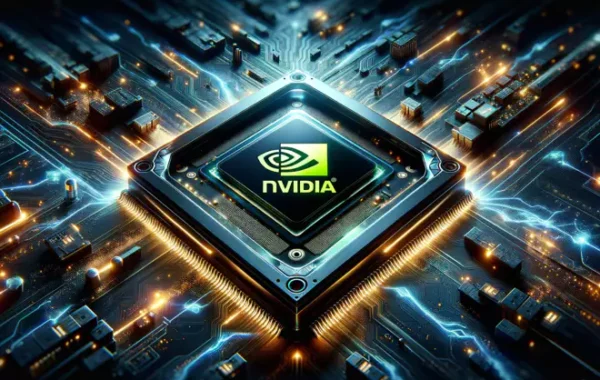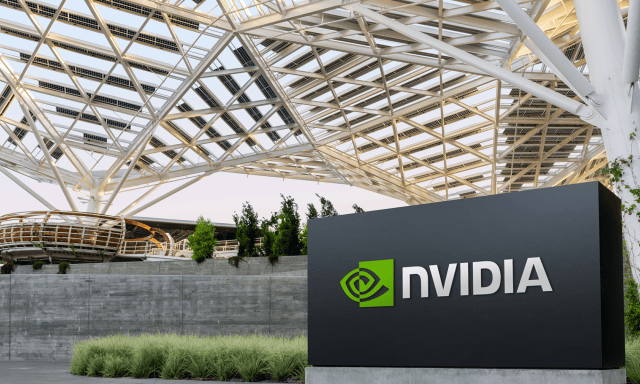In a sharp twist of fortune, Nvidia’s shares Plummet, Known for its pioneering AI chips – lost $430 billion in market value over three sudden trading days. This unforeseen crash shook the tech world, leaving those involved puzzled as they tried to grasp the reasons behind Nvidia’s financial struggles.
The fall in Nvidia’s shares obliterated much of its recent progress. This has led to concerns about the solidity of the AI chip sector and the semiconductor industry at large. Nevertheless, even with this loss, Nvidia’s stock has seen a net increase of over 140% this year, underscoring the unpredictable nature of today’s tech market.
Key Takeaways
- Nvidia’s shares dropped 13% in three trading days
- $430 billion in market value was erased
- The stock is still up 140% for the year
- Tech sector volatility is highlighted
- Questions arise about AI chip market stability
- Investors seek to understand the cause of the decline
Understanding Nvidia’s Market Position
Nvidia has greatly advanced in the tech realm, solidifying its status in AI and semiconductors. Its impressive growth trajectory has pushed its market valuation to unprecedented levels.
Nvidia’s Rise as a Tech Giant
Nvidia advanced swiftly in the tech sphere. It reached a staggering $3.335 trillion in market value, temporarily topping Apple and Microsoft as the leading listed company globally. This achievement highlights Nvidia’s command in the AI chip market, boasting an over 80% market share.
Recent Market Valuation and Growth
However, a recent drop in Nvidia’s shares cost the company $430 billion. This decline, around 15% in stock price, led to losing its brief status as the world’s top listed company. Furthermore, it shed over $500 billion since its peak for valuation.
Significance in the AI and Semiconductor Industry
Nvidia’s presence in AI and semiconductors is significant. Analysts predict $120 billion in sales for Nvidia this year, almost doubling that of 2023. Its CUDA software has notably enhanced its AI chip leadership. Even with recent market shifts, Nvidia’s value significantly outpaces the projected global chip sales for the next year by nearly fivefold.
The Sudden Stock Market Crash
The tech stock selloff severely impacted Nvidia, wiping out $431 billion of its market cap since last Friday. This abrupt crash mirrors wider market shifts and highlights mounting concerns within the semiconductor sector. Over just a three-day period, Nvidia’s shares dropped nearly 13%, its worst performance since 2022.
Nvidia isn’t the only casualty of the semiconductor market’s decline. Tech behemoths, including Super Micro Computer and Taiwan Semiconductor Manufacturing, faced significant value reductions, plummeting by 8.5% and 3.8%, respectively. This market trend outlines a change in how investors view tech stocks, particularly those heavily involved in artificial intelligence development.
Despite these challenges, Nvidia’s recent growth figures are commendable. The company celebrated its highest-ever quarterly revenue, hitting $26 billion – a remarkable 262% jump from the previous year. Projections for Nvidia’s fiscal year 2025 are optimistic, with an expected $119.9 billion in revenue, highlighting its growth trajectory.
The volatile nature of the tech sector raises concerns about market dependability. Nvidia’s significant contribution to the S&P 500’s advancement underscores worries regarding market breadth. With the semiconductor scene currently fraught, both investors and analysts are on high alert for any indicators of improvement or continued downturn.
Nvidia’s Shares Plummet: A Closer Look
Nvidia shocked both investors and analysts with a sudden drop in stock value. This drop eliminated $430 billion of the company’s worth rapidly. Such a significant decline sharply contrasts with its strong early-year performance.
Timing and Magnitude of the Drop
 In a mere three days, Nvidia’s shares fell by nearly 13%, its worst performance since 2022. This drop caused its value to plummet by $430 billion. Simultaneously, the company had just achieved an all-time high on Thursday, leading to a loss of over $540 billion across three days.
In a mere three days, Nvidia’s shares fell by nearly 13%, its worst performance since 2022. This drop caused its value to plummet by $430 billion. Simultaneously, the company had just achieved an all-time high on Thursday, leading to a loss of over $540 billion across three days.
Comparison to Previous Performance
This recent plunge sharply contrasts with Nvidia’s earlier steady growth. Despite the setback, its shares had surged by a remarkable 190% over 12 months. This volatility outlines the turbulent nature of Nvidia’s market and the tech industry in general.
Impact on Market Capitalization
The share drop had a massive impact on Nvidia’s market standing. Now, Nvidia’s value ranks it below Microsoft and Apple, with a market cap of $2.97 trillion. This fall considerably altered its position among the most valuable enterprises globally, underscoring the enormity of the stock price decline.
Despite the turbulence, many analysts hold a positive outlook on Nvidia. They forecast a significant revenue increase for the year ending January 2025, estimating it to double from the previous year. Such projections indicate a promising future, hinting at possible recovery and growth despite the recent share decrease.
Factors Contributing to Nvidia’s Stock Decline
Nvidia’s recent stock plummet has startled the tech industry. In just three trading sessions, the company’s shares fell over 15%, wiping out nearly $550 billion in market value. This sharp drop prompts a look into what’s causing Nvidia’s financial troubles.
The first factor is a possible decrease in ai chip demand. While Nvidia’s stock soared by 180% this year, doubts remain about the longevity of AI chip demand. The company’s significant focus on the AI market means it’s sensitive to changes in investing trends and technological advances.
External market conditions are also to blame. In one day, Nvidia saw its stock drop by over 6%, which cut $200 billion from its market capitalization. This reflects a wider trend, as stock declines of over 10% happened in half the years between 2002 and 2021.
Recent insider trading is stirring concern too. CEO Jensen Huang sold almost $95 million in stock, spurring worries about Nvidia’s future. His sales, paired with fears of a slump in AI chip demand, have worsened investor anxiety over Nvidia’s fiscal future.
From a technical standpoint, there are crucial support levels at $130 and $124, with a significant point at $115. A further drop could drag Nvidia’s stock closer to $100, deepening the company’s financial troubles.
Tech Sector Volatility and Its Impact
The tech stock selloff has reverberated across the market. Nvidia’s recent plummet wiped out $430 billion in value. This drastic change highlights the tech sector’s wild fluctuations, impacting major players.
Overall Market Trends
On Monday, Nvidia’s stocks fell 6.7%, echoing a wider sense of market uncertainty. The Nasdaq, home to tech companies, also dropped by 1.2%. Such shifts are common in the tech realm, where Nvidia’s fortunes mirror broader patterns.
Comparison with Other Tech Giants
Nvidia faces a notable decline, yet its situation isn’t unique. In contrast, the Magnificent Seven tech companies light up the S&P 500 with their 111% average surge. This stark difference shows the tech world’s volatile but potentially rewarding nature.
Historical Perspective on Tech Stock Fluctuations
This isn’t the first time Nvidia has seen sharp changes. Just two years ago, its stock price rose by a staggering 700%. Amidst the recent downturn, Nvidia’s stock is still up by almost 150% since the start of 2024. This up-and-down journey highlights the tech field’s extreme variability and growth potential.
AI Chip Demand: Current State and Future Projections
The semiconductor industry downturn has raised issues around AI chip demand. Nvidia, a significant force in the market, faces various hurdles despite recent strong showings. Since April 2023, the company has consistently outperformed sales predictions; in August alone, it surpassed forecasts by an impressive 23%.
Despite challenges, Nvidia maintains a 90% stake in AI chips, highlighting its dominance. The first quarter saw the company achieve a new record in data center revenue, reaching $22.6 billion. This sector alone constituted 87% of its total revenues, showing the growing demand for AI infrastructure initiatives.
Looking into the future, analysts forecast Nvidia’s sales for the year ending January 2025 to hit nearly $111 billion, marking an 80% increase from the prior year. However, concerns over an ai chip demand lull persist. Export controls have significantly reduced Nvidia’s Chinese market stake, pulling it down from 20-25% to single digits.
Nevertheless, a sense of hope endures. A notable Wall Street analyst has dramatically increased their forecast for Nvidia’s AI chip orders in China for 2024. They’ve raised expectations from 150,000-200,000 to 600,000-800,000 units, a shift that could generate an additional $9-12 billion in revenue. This revised outlook hints at a possible recovery from the current downturn in the semiconductor sector.
Wall Street’s Reaction and Analyst Perspectives
When Nvidia’s stock prices fell, the financial market saw massive losses. A staggering $430 billion in value was wiped out. This event pushed Wall Street into a state of alarm and brought worries about Nvidia’s financial health to light. Consequently, analysts rushed to rethink their predictions for the tech company’s future.
Expert Opinions on Nvidia’s Future
 Despite the setback, many professionals believe it’s just a minor pause. They note signs of recovery as Nvidia’s shares climbed by 5.3%. This uptick was a welcome relief after a three-day dive that saw a 13% drop.
Despite the setback, many professionals believe it’s just a minor pause. They note signs of recovery as Nvidia’s shares climbed by 5.3%. This uptick was a welcome relief after a three-day dive that saw a 13% drop.
Such resilience hints at strong faith in Nvidia’s potential over the long haul.
Short-term vs. Long-term Outlook
While the recent dip has been severe, some maintain a positive stance on Nvidia. They highlight the company’s dominant position in the AI chip sector. Yet, not all share this optimism. A comparison to past market reactions shows that the S&P 500 usually drops by 20% over the 250 days post-Fed rate cuts.
Investor Sentiment Analysis
Investor impressions are currently diverse. The plummet in Nvidia’s stocks has profoundly impacted Wall Street and investor opinions. Some view this as a chance to buy, while others tread cautiously, anticipating further market adjustments. This mixed sentiment is further complicated by the tech sector’s wild nature, evident through varying stocks like SolarEdge Technologies and Carnival.
Nvidia’s Response and Strategic Moves
With its stock plunging, Nvidia is in a tough spot, wiping out $430b in three days. This 13% drop has everyone discussing what’s next for the company.
Yet, despite this fall, Nvidia’s shares have exploded by 140% this year. The AI trend pushing its growth could’ve exceeded what the market predicted.
The pioneer of Nvidia urges investors to keep their eyes on the future. He views the current setback as a chance for those looking ahead.
This market shake has caused a split on where to put investments. Some, such as the head of Kace Capital Advisors, are holding a big chunk in Nvidia. He’s got 13% of his portfolio in the company at 63 years old.
But, smart money might be looking elsewhere. Analysts propose taking profits from Nvidia and venturing into other fields. Areas like consumer staples, utilities, and financials could be interesting for those wanting to broaden their investments.
Nvidia’s course through this choppy market is vital. How it tackles issues and remains strong in AI and semiconductors is closely watched. Both investors and market experts are keen to see its next moves.
Broader Implications for the Semiconductor Industry
The semiconductor industry is bracing for tough times. Nvidia’s market value dropped by $430 billion recently, shaking the entire sector. This event forces reflection on supply chains, how markets operate, and the legal scene.
Supply Chain Considerations
Worldwide chip supply chains are vulnerable to market changes. With the current industry slowdown, production schedules and inventory management are affected. Therefore, companies adjust to new demand trends, notably as AI chip orders decrease.
Competition and Market Dynamics
Nvidia’s firm grip on the AI chip market is under the microscope. Its stock has skyrocketed by 138% this year, trumping the Nasdaq 100. Such achievements have drawn more competition, potentially altering market dynamics. As a result, semiconductor players are pressured by semiconductor players to innovate and expand their product range.
Regulatory Environment
The regulatory environment for semiconductors is getting stricter. Establishing Safe Superintelligence Inc. points to the urgency for AI safety protocols. International governments are considering adding rules for AI chip creation and application, complicating the industry’s path forward.
With these challenges ahead, the semiconductor sector’s endurance will be deeply tested. Success will hinge on how well companies can adapt to market transformations, foster new innovation, and manage the mounting regulatory hurdles.
Conclusion
The recent tech stock selloff has been a cause of concern, particularly with Nvidia’s significant loss in share value. In a matter of three trading days, the stock dropped by 12.8%, pulling from $135.58 to $118.11. This sharp decrease underlines the tech sector’s volatility, affecting even its front-runners.
 However, Nvidia’s future prospects look promising despite the recent setback. Its 200-day SMA at $70.14 stands significantly lower than its present value, hinting at a robust market trajectory. The company holds a staggering 90% share in the AI chips market, justifying its lofty worth. With estimates pointing to a revenue hike to $60.9 billion this year, plus a future tripling within four years, the growth outlook is strong.
However, Nvidia’s future prospects look promising despite the recent setback. Its 200-day SMA at $70.14 stands significantly lower than its present value, hinting at a robust market trajectory. The company holds a staggering 90% share in the AI chips market, justifying its lofty worth. With estimates pointing to a revenue hike to $60.9 billion this year, plus a future tripling within four years, the growth outlook is strong.
Amid continuing industry challenges, staying informed about market trends and regulations is critical for investors. The recent drop in stock prices supports the need for diversification and strategic risk management in the rapidly evolving tech investment landscape. Though Nvidia’s shares have taken a hit in the short run, its leading position and expansion in the AI and semiconductor fields could signal prospects for those investing for the long haul.
Read More: How to learn ChatGPT? Step-by-Step Beginner’s Guide, 2024



